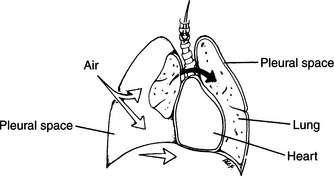CHEST INJURY
BROKEN RIBS
Direct force applied to the chest wall can break the ribs, causing extreme pain with breathing, collapse of a lung (pneumothorax), or both. If the right lower ribs are broken, be alert to the possibility of a bruised or cracked liver, which lies directly below; if the left lower ribs are broken, the underlying spleen may be injured.
FLAIL CHEST
If a number of ribs are broken or detached in series, so that the affected section of the chest wall cannot expand and contract in synchrony with the rest of the chest, then a flail chest (Figure 26) is present. Depending on the size of the flail segment, this can cause severe respiratory compromise. Occasionally, the flail segment moves with breathing in a direction opposite to the rest of the chest wall.
PNEUMOTHORAX
A pneumothorax is a collapsed lung created when there is an air leak (from the lung or from a penetrating wound of the chest wall) into the space between the lung and the inside of the chest wall (pleural space). In the normal situation, the pleural space is undetectable and filled with negative pressure, which allows the lung to expand and contract with chest wall movement (breathing). When air leaks into the pleural space, either from a lung injury or from a hole in the chest wall, the lung collapses. The lung may then be increasingly compressed if air accumulates in the pleural space under pressure (Figure 27). A collapsed lung is recognized by diminished or absent breath sounds (heard through a stethoscope or an ear held against the chest wall) on the affected side, accompanied by chest pain, shortness of breath, and difficult breathing. If air accumulates under pressure in the affected pleural space, this becomes a “tension” pneumothorax. It is characterized by rapidly progressive difficulty in breathing associated with a pneumothorax, cyanosis (blue skin discoloration), distended neck (jugular) veins, and a shift of the windpipe away from the affected side.
Stay updated, free articles. Join our Telegram channel

Full access? Get Clinical Tree






